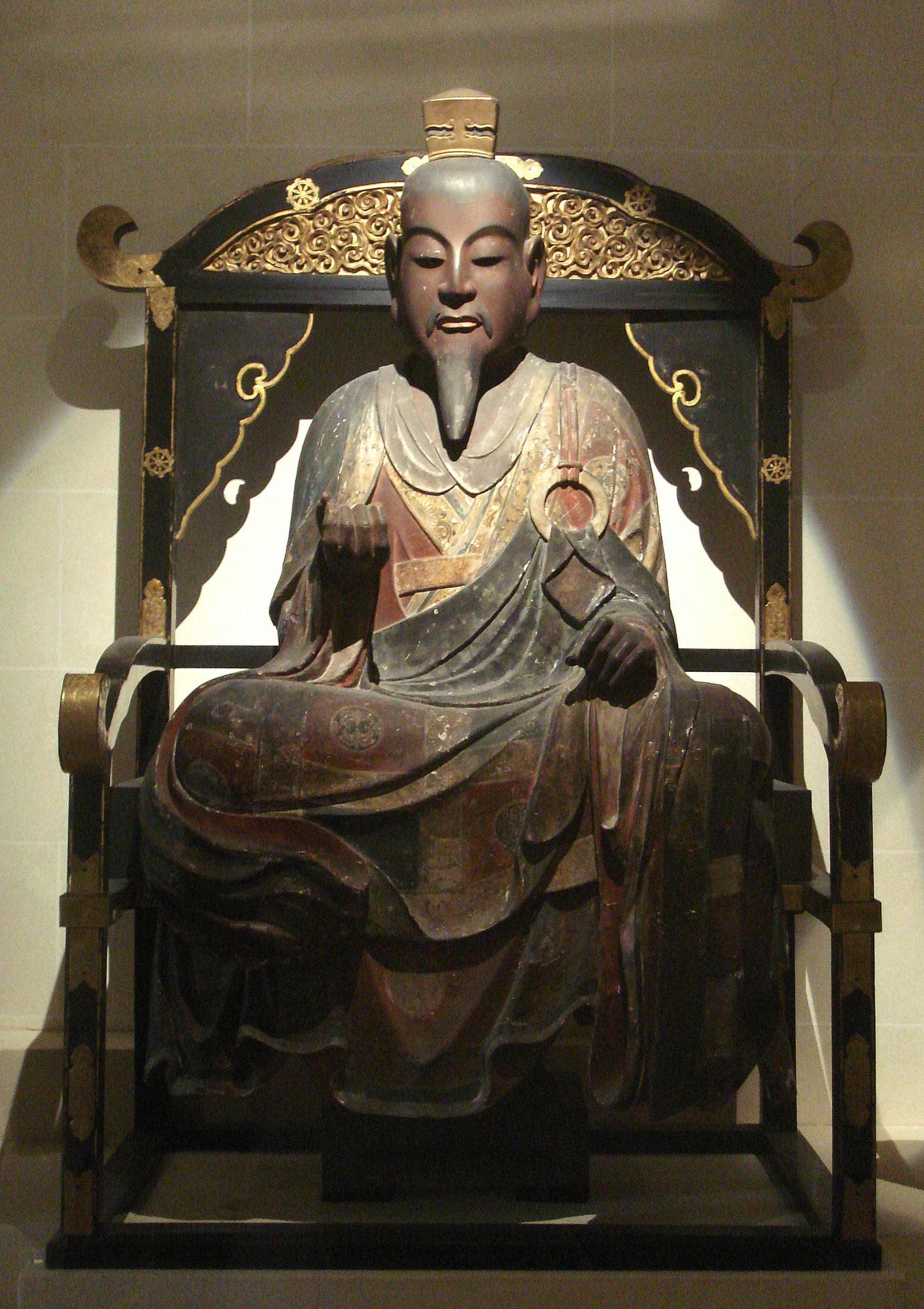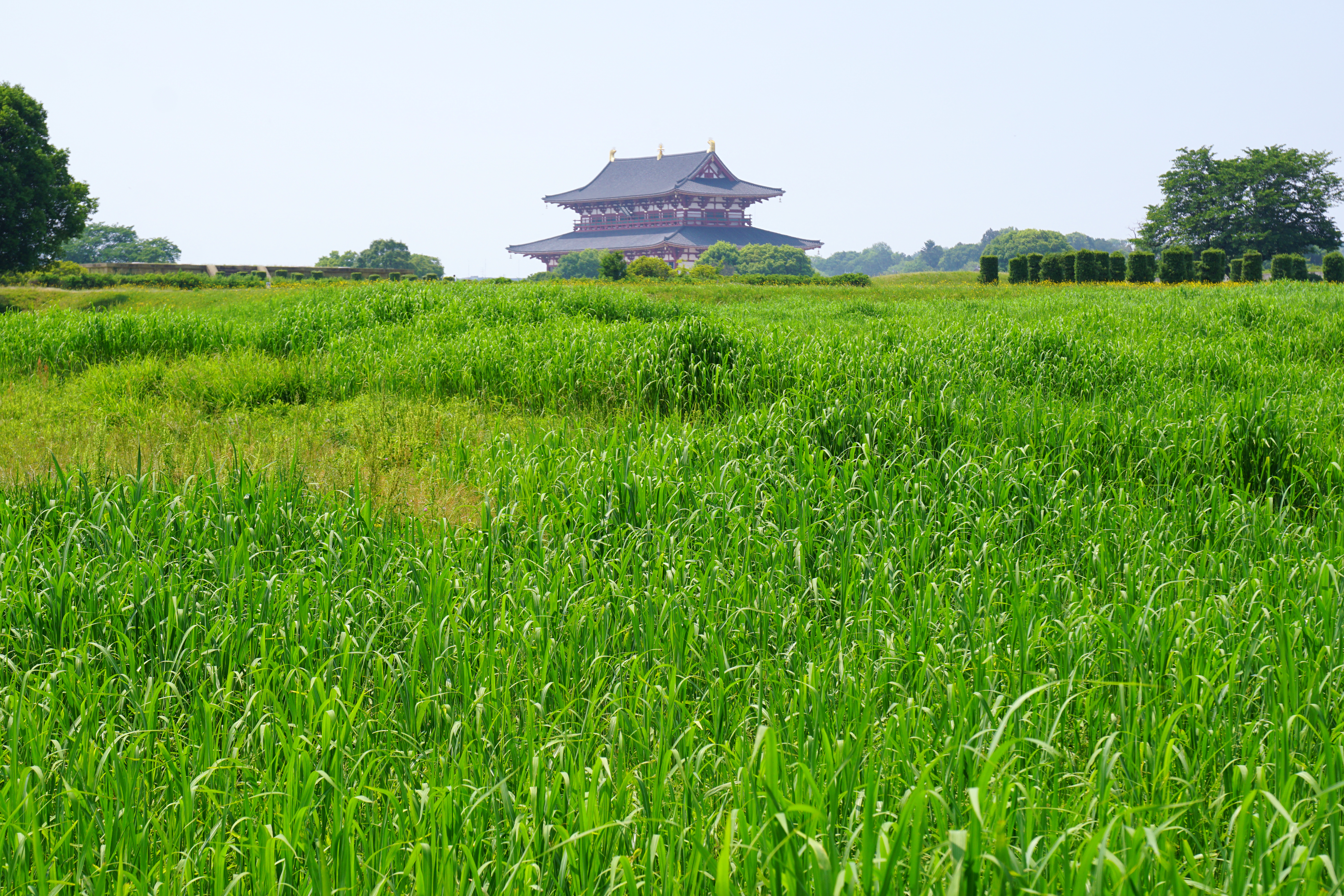|
Daian-ji
was founded during the Asuka period and is one of the Seven Great Temples of Nara, Japan. History The Nihon Shoki records the founding of the , predecessor of the Daian-ji, in 639 during the reign of Emperor Jomei. A nine-story pagoda was added shortly afterwards. Moved during the reign of Emperor Tenmu, excavations have uncovered the foundations of the site of the , as it was then known, seven hundred metres to the south of Mount Kagu. Like the Yakushi-ji, and Gangō-ji, the temple relocated to the new capital of Heijō-kyō in 716–17, and it was rebuilt as the Daian-ji in 729. Its importance declined when the capital moved again to Kyoto at the end of the Nara period. A succession of fires, a typhoon in 1459 and earthquakes in 1585 and 1596 destroyed most of the temple. The stone bases of the former twin pagodas were removed for reuse at Kashihara Jingū in 1889, while the ruins of the other buildings lie in adjacent properties. Treasures The temple houses nine statue ... [...More Info...] [...Related Items...] OR: [Wikipedia] [Google] [Baidu] |
Yakushi-ji
is one of the most famous imperial and ancient Buddhist temples in Japan, and was once one of the Nanto Shichi Daiji, Seven Great Temples of Nanto, located in Nara, Nara, Nara. The temple is the headquarters of the Hossō school of Japanese Buddhism. Yakushi-ji is one of the sites that are collectively inscribed as a United Nations Educational, Scientific and Cultural Organization, UNESCO World Heritage Site under the name of "Historic Monuments of Ancient Nara." The temple's main object of veneration, Bhaisajyaguru, Yakushi Nyorai, also known as "The Medicine Buddha", was one of the first Buddhist Deity, Deities to arrive in Japan from China in 680, and gives the temple its name. History The Jinshin Wars in Japan in 672 resulted in moving the capital from Otsu back to Asuka. The movement of the capital was due to family disputes over money and power leading to civil war between Prince Naka and Prince Ōama. Prince Ōama desired power over Prince Naka's son, who was favored by h ... [...More Info...] [...Related Items...] OR: [Wikipedia] [Google] [Baidu] |
Historical Sites Of Prince Shōtoku
The Historical Sites of Prince Shōtoku (聖徳太子御遺跡霊場, ''Shōtoku taishi goiseki reijō'') are a group of 28 Buddhist temples in Japan related to the life of Prince Shōtoku , also known as or , was a semi-legendary regent and a politician of the Asuka period in Japan who served under Empress Suiko. He was the son of Emperor Yōmei and his consort, Princess Anahobe no Hashihito, who was also Yōmei's younger half- .... Directory {{DEFAULTSORT:Historical Sites of Prince Shotoku Buddhist temples in Nara Prefecture Buddhist temples in Osaka Prefecture Buddhist temples in Kyoto Prefecture Buddhist temples in Hyōgo Prefecture Buddhist pilgrimage sites in Japan Religious buildings and structures in Kyoto Prefecture Prince Shōtoku Buddhism in the Asuka period ... [...More Info...] [...Related Items...] OR: [Wikipedia] [Google] [Baidu] |
Nanto Shichi Daiji
Nanto Shichi Daiji (南都七大寺), literally "the seven great temples of the southern capital (meaning Nara)", is a historical common name generally referring to the powerful and influential seven Buddhist temples located in Nara. There have been some changes as to which temples are included over the years, since there have been fluctuations in power. The following is a list as it stood at the early stage, all of which were originally built by imperial order: This book is a collection of travel records to the seven great temples in Nara, published in Heian Period. A copy of the 13th century is shown at Nara National Museum. Designated National Treasure. *Daian-ji (大安寺) *Gangō-ji (元興寺) *Hōryū-ji (法隆寺) (located close to the border of modern Nara city, in the town of Ikaruga, Nara) *Kōfuku-ji (興福寺) *Saidai-ji (西大寺) *Tōdai-ji (東大寺) *Yakushi-ji (薬師寺) Sometimes the temples were called "the fifteen great temples of the southern capital" to ... [...More Info...] [...Related Items...] OR: [Wikipedia] [Google] [Baidu] |
Nara, Nara
is the capital city of Nara Prefecture, Japan. As of 2022, Nara has an estimated population of 367,353 according to World Population Review, making it the largest city in Nara Prefecture and sixth-largest in the Kansai region of Honshu. Nara is a core city located in the northern part of Nara Prefecture bordering the Kyoto Prefecture. Nara was the capital of Japan during the Nara period from 710 to 794 as the seat of the Emperor before the capital was moved to Kyoto. Nara is home to eight temples, shrines, and ruins, specifically Tōdai-ji, Saidai-ji, Kōfuku-ji, Kasuga Shrine, Gangō-ji, Yakushi-ji, Tōshōdai-ji, and the Heijō Palace, together with Kasugayama Primeval Forest, collectively form the Historic Monuments of Ancient Nara, a UNESCO World Heritage Site. Etymology By the Heian period, a variety of different characters had been used to represent the name Nara: , , , , , , , , , , , , , , , and . A number of theories for the origin of the name "Nara" have been pro ... [...More Info...] [...Related Items...] OR: [Wikipedia] [Google] [Baidu] |
Heijō-kyō
was the Capital of Japan during most of the Nara period, from 710 to 740 and again from 745 to 784. The imperial palace is a listed UNESCO World Heritage together with other places in the city of Nara (cf. Historic Monuments of Ancient Nara). Empress Genmei ordered the Imperial capital moved from Fujiwara-kyō to Heijō-kyō in 708, and the move to Heijō-kyō was complete in 710. Heijō-kyō was modeled after Chang'an, the capital of Tang-dynasty China, although Heijō-kyō lacked walls. In the city, merchants and traders from China, Korea and India introduced various foreign cultures to Heijō-kyō through the Silk Road. As a result, Heijō-kyō flourished as Japan's first international and political capital, with a peak population of between 50,000 and 100,000. The overall form of the city was an irregular rectangle, and the area of city is more than 25 km2. Architecture In the area of Heijō-kyō, there are ancient Buddhist temples, and some temples are also l ... [...More Info...] [...Related Items...] OR: [Wikipedia] [Google] [Baidu] |
Nara Prefecture
is a prefecture of Japan located in the Kansai region of Honshu. Nara Prefecture has a population of 1,321,805 and has a geographic area of . Nara Prefecture borders Kyoto Prefecture to the north, Osaka Prefecture to the northwest, Wakayama Prefecture to the southwest, and Mie Prefecture to the east. Nara is the capital and largest city of Nara Prefecture, with other major cities including Kashihara, Ikoma, and Yamatokōriyama. Nara Prefecture is located in the center of the Kii Peninsula on Japan's Pacific Ocean coast, and is one of only eight landlocked prefectures. Nara Prefecture has the distinction of having more UNESCO World Heritage listings than any other prefecture in Japan. History Nara Prefecture region is considered one of the oldest regions in Japan, having been in existence for thousands of years, and is widely viewed as the Japanese cradle of civilization. Like Kyoto, Nara was one of Imperial Japan's earliest capital cities. The current form of Nara Prefec ... [...More Info...] [...Related Items...] OR: [Wikipedia] [Google] [Baidu] |
Important Cultural Properties Of Japan
An The term is often shortened into just is an item officially classified as Tangible Cultural Property by the Japanese government's Agency for Cultural Affairs ( Ministry of Education, Culture, Sports, Science and Technology) and judged to be of particular importance to the history, arts, and culture of the Japanese people. Classification of Cultural Properties To protect the cultural heritage of Japan, the Law for the Protection of Cultural Properties was created as a under which important items are appropriated as Cultural Properties,In this article, capitals indicate an official designation as opposed to a simple, unofficial definition, e.g "Cultural Properties" as opposed to "cultural properties". thus imposing restrictions to their alteration, repair and export. Besides the "designation system", there exists a , which guarantees a lower level of protection and support to Registered Cultural Properties. Cultural Properties are classified according to their nature. It ... [...More Info...] [...Related Items...] OR: [Wikipedia] [Google] [Baidu] |
Four Heavenly Kings
The Four Heavenly Kings are four Buddhist gods, each of whom is believed to watch over one cardinal direction of the world. In Chinese mythology, they are known collectively as the "Fēng Tiáo Yǔ Shùn" () or "Sìdà Tiānwáng" (). In the ancient language Sanskrit, they are called the "Chaturmahārāja" (चतुर्महाराज) or "Chaturmahārājikādeva": "Four Great Heavenly Kings". The Hall of Four Heavenly Kings is a standard component of Chinese Buddhist temples. Names The Kings are collectively named as follows: The Four Heavenly Kings are said to currently live in the Cāturmahārājika heaven (Pali: Cātummahārājika, "Of the Four Great Kings") on the lower slopes of Mount Sumeru, which is the lowest of the six worlds of the devas of the Kāmadhātu. They are the protectors of the world and fighters of evil, each able to command a legion of supernatural creatures to protect the Dharma. File:Guardian of Phra Meru Mas of Bhumibol Adulyadej - Vessav ... [...More Info...] [...Related Items...] OR: [Wikipedia] [Google] [Baidu] |
Agency For Cultural Affairs
The is a special body of the Japanese Ministry of Education, Culture, Sports, Science and Technology (MEXT). It was set up in 1968 to promote Japanese arts and culture. The agency's budget for FY 2018 rose to ¥107.7 billion. Overview The agency's Cultural Affairs Division disseminates information about the arts within Japan and internationally, and the Cultural Properties Protection Division protects the nation's cultural heritage. The Cultural Affairs Division is concerned with such areas as art and culture promotion, art copyrights, and improvements in the national language. It also supports both national and local arts and cultural festivals, and it funds traveling cultural events in music, theater, dance, art exhibitions, and film-making. Special prizes are offered to encourage young artists and established practitioners, and some grants are given each year to enable them to train abroad. The agency funds national museums of modern art in Kyoto and Tokyo and The National ... [...More Info...] [...Related Items...] OR: [Wikipedia] [Google] [Baidu] |
Kannon
Guanyin () is a Bodhisattva associated with compassion. She is the East Asian representation of Avalokiteśvara ( sa, अवलोकितेश्वर) and has been adopted by other Eastern religions, including Chinese folk religion. She was first given the appellation of "Goddess of Mercy" or "Mercy Goddess" by Jesuit missionaries in China. Guanyin is short for Guanshiyin, which means " he One WhoPerceives the Sounds of the World." On the 19th day of the sixth lunar month, Guanyin's attainment of Buddhahood is celebrated. Some Buddhists believe that when one of their adherents departs from this world, they are placed by Guanyin in the heart of a lotus, and then sent to the western pure land of Sukhāvatī. Guanyin is often referred to as the "most widely beloved Buddhist Divinity" with miraculous powers to assist all those who pray to her, as is mentioned in the ''Pumen chapter'' of ''Lotus Sutra'' and ''Kāraṇḍavyūha Sūtra''. Several large temples in East Asia ... [...More Info...] [...Related Items...] OR: [Wikipedia] [Google] [Baidu] |









